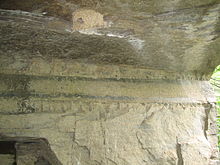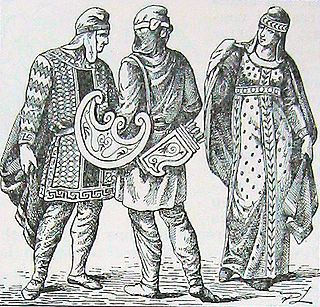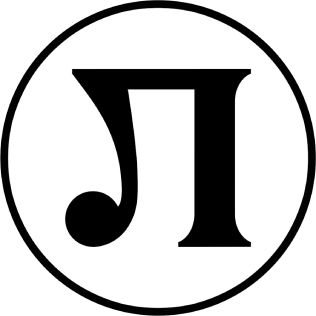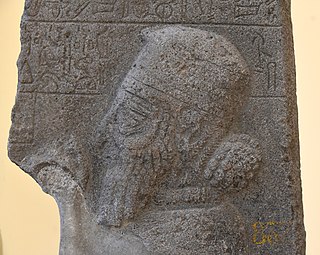

The Sitovo inscription is an inscription in Bulgaria that has yet to be satisfactorily translated.


The Sitovo inscription is an inscription in Bulgaria that has yet to be satisfactorily translated.
The inscription was discovered in 1928, on the wall of a rock shelter near the village of Sitovo, close to Plovdiv, Bulgaria. It was first documented by amateur archaeologist Alexander Peev. The inscription is in two lines which are 3.40 metres (11.2 ft) long. The written signs are 40 centimetres (16 in) tall. The inscription has been tentatively dated to between 300 and 100 BCE. [1]
In 1943, Peev was executed by firing squad on suspicion of sending a coded message to the Soviet Union. He had sent an example of the text to Soviet archaeologists, in the hope that they could decipher its meaning. [2] [3] The inscription was published in 1950 by Z. R. Morfova. [4] Peev was posthumously awarded the Order of Lenin for his resistance efforts against the Bulgarian government. [2]
Amateurs and professionals have attempted to translate the inscription. It has been variously identified as local ancient language, Celtic, Slavic, and Phrygian. [1] [5]

The Behistun Inscription is a multilingual Achaemenid royal inscription and large rock relief on a cliff at Mount Behistun in the Kermanshah Province of Iran, near the city of Kermanshah in western Iran, established by Darius the Great. It was important to the decipherment of cuneiform, as it is the longest known trilingual cuneiform inscription, written in Old Persian, Elamite, and Babylonian.
The Thracian language is an extinct and poorly attested language, spoken in ancient times in Southeast Europe by the Thracians. The linguistic affinities of the Thracian language are poorly understood, but it is generally agreed that it was an Indo-European language.
The Phrygian language was the Indo-European language of the Phrygians, spoken in Anatolia, during classical antiquity.

The Phrygians were an ancient Indo-European speaking people who inhabited central-western Anatolia in antiquity.

The Seikilos epitaph is an Ancient Greek inscription that preserves the oldest surviving complete musical composition, including musical notation. Commonly dated between the 1st and 2nd century AD, the inscription was found engraved on a pillar (stele) from the ancient Hellenistic town of Tralles in 1883. The stele includes two poems; an elegiac distich and a song with vocal notation signs above the words. A Hellenistic Ionic song, it is either in the Phrygian octave species or Ionian (Iastian) tonos. The melody of the song is recorded, alongside its lyrics, in ancient Greek musical notation. While older music with notation exists, all of it is in fragments; the Seikilos epitaph is unique in that it is a complete, though short, composition.

PFC Lokomotiv Plovdiv, commonly known as Loko Plovdiv, is a Bulgarian professional association football club based in Plovdiv. Lokomotiv's home ground is the Lokomotiv Stadium which is situated in Lauta Park and has a capacity of 14,500 spectators.

The Gezer calendar is a small limestone tablet with an early Canaanite inscription discovered in 1908 by Irish archaeologist R. A. Stewart Macalister in the ancient city of Gezer, 20 miles west of Jerusalem. It is commonly dated to the 10th century BCE, although the excavation was not stratified.
The Mysian language was spoken by Mysians inhabiting Mysia in north-west Anatolia.

The Museum of Anatolian Civilizations is located on the south side of Ankara Castle in the Atpazarı area in Ankara, Turkey. It consists of the old Ottoman Mahmut Paşa bazaar storage building, and the Kurşunlu Han. Because of Atatürk's desire to establish a Hittite museum, the buildings were bought upon the suggestion of Hamit Zübeyir Koşay, who was then Culture Minister, to the National Education Minister, Saffet Arıkan. After the remodelling and repairs were completed (1938–1968), the building was opened to the public as the Ankara Archaeological Museum.
The linguistic classification of the ancient Thracian language has long been a matter of contention and uncertainty, and there are widely varying hypotheses regarding its position among other Paleo-Balkan languages. It is not contested, however, that the Thracian languages were Indo-European languages which had acquired satem characteristics by the time they are attested.

Warpalawas II was a Luwian king of the Syro-Hittite kingdom of Tuwana in the region of Tabal who reigned during the late 8th century BC, from around c. 740 to c. 705 BC.

In classical antiquity, Phrygia was a kingdom in the west-central part of Anatolia, in what is now Asian Turkey, centered on the Sangarios River. After its conquest, it became a region of the great empires of the time.

Vladimir Emmanuilovich Orël was a Russian linguist, professor, and etymologist.

Aizanoi, Latinized as Aezani, was a Phrygian city in western Anatolia. It was located at the site of the modern village of Çavdarhisar, near Kütahya, on both sides of the Penkalas river, c. 1,000 m (3,300 ft) above sea level. The city was an important political and economic centre in Roman times; surviving remains from the period include a well-preserved Temple of Zeus, a combined theatre-stadium complex, and a round building, probably a macellum, inscribed with a copy of the Price Edict of Diocletian. The city fell into decline in Late Antiquity. In 2012 the site was submitted for inclusion on the UNESCO World Heritage List.
Trojan script is a series of signs of unknown origin found on vessels from Troy excavated by Heinrich Schliemann's expedition. Their status is disputed.

Yazılı, Phrygian Yazılıkaya, or Midas Kenti is a neighbourhood of the municipality and district of Alpu, Eskişehir Province, Turkey. Its population is 45 (2022). It is located about 27 km south of Seyitgazi, 66 km south of Eskişehir, and 51 km north of Afyonkarahisar. It is known for its Phrygian archaeological remains and inscription mentioning Midas.
Graeco-Phrygian is a proposed subgroup of the Indo-European language family which comprises the Hellenic and Phrygian languages.

Philippopolis is one of the names of the ancient city situated where Plovdiv is today. The city became one of the largest and most important in the region and was called "the largest and most beautiful of all cities" by Lucian. During most of its recorded history, the city was known by the name Philippopolis after Philip II of Macedon. Philippopolis became part of the Roman empire and capital of the Roman province of Thracia. According to Ammianus Marcellinus, Philippopolis had a population of 100,000 in the Roman period.
The second inscription is a rock-text near Sitovo village at 30 km south-east of Plovdiv in the Rhodopes Range. After their own autopsia Bayun-Orel 1991, 144-148, dated the inscription in III-I c. B.C. and saw on the rock "Ipta" as "figurine, cult object, image (in paredria?) with Bacchus' figurine."[sic]